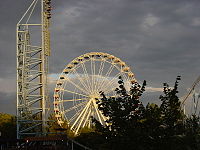Predicting the Position of a Rotating System
(claimed by Anna Marie Whitacre, awhitacre7)

In order to provide a cohesive and detailed model of the motion of a rotating object (including Systems with Zero Torque and Systems with Nonzero Torque) it is necessary to predict the position of the system.
The Main Idea
The position of a rotating system can be predicted by predicting the angle over which the object will rotate though out time. Basically, the key to finding out how much a rotating object has moved (over a specific time interval) is the angle through which it moves.
A Mathematical Model
Given that the system in question is indeed rotating, the update form of The Angular Momentum Principle is always applied about the the center of mass in our calculations.
The update form of the Angular Momentum Principle is as follows: [math]\displaystyle{ \vec{L}_{rot,f}=\vec{L}_{rot,i}+\vec{\tau}_{net}\Delta t }[/math] where [math]\displaystyle{ {L} }[/math] is rotational angular momentum and [math]\displaystyle{ \tau }[/math] is net torque from the surroundings.
In basic situations, the update form of the Angular Momentum Principle can further be simplified to account for The Moments of Inertia, [math]\displaystyle{ I }[/math], and the Angular Velocity, [math]\displaystyle{ \omega }[/math] of the rotating system. This simplification of the update form of the Angular Momentum Principle yields the following mathematical equation: [math]\displaystyle{ I\omega _{f}=I\omega _{i}+RF\Delta t }[/math] where net torque, [math]\displaystyle{ \vec{\tau}_{net} }[/math] is simplified to the product of all the forces acting on the system and the locations to which these forces are applied, [math]\displaystyle{ RF }[/math].
A Computational Model
How do we visualize or predict using this topic. Consider embedding some vpython code here Teach hands-on with GlowScript
Examples
Be sure to show all steps in your solution and include diagrams whenever possible
Simple
Middling
Difficult
Connectedness
- How is this topic connected to something that you are interested in?
- How is it connected to your major?
- Is there an interesting industrial application?


In the theme and amusement park industry (e.g. Six Flags and Disney World), the aforementioned method of predicting the position of a rotating system can be applied to determine how far a certain rider has moved on either Mickey's Fun World or Colossus. This prediction of a rider's position after a certain amount of time could be applied by economists to determine the ideal speed and time interval to run their respective ferris wheels to yield an optimal economic profit with respect to the cost of admission tickets.
History
Put this idea in historical context. Give the reader the Who, What, When, Where, and Why.
See also
Are there related topics or categories in this wiki resource for the curious reader to explore? How does this topic fit into that context?
Further reading
Books, Articles or other print media on this topic
External links
Internet resources on this topic
References
This section contains the the references you used while writing this page